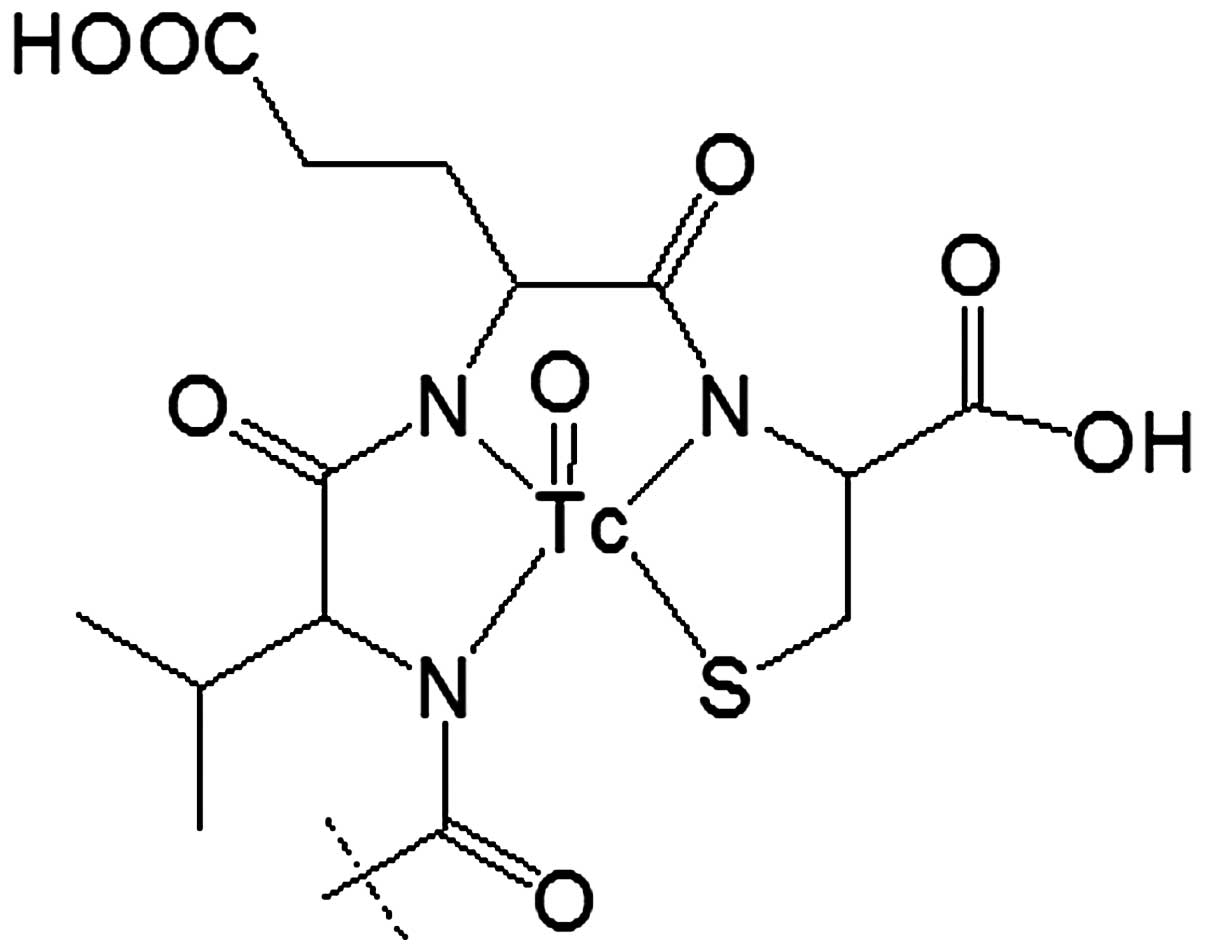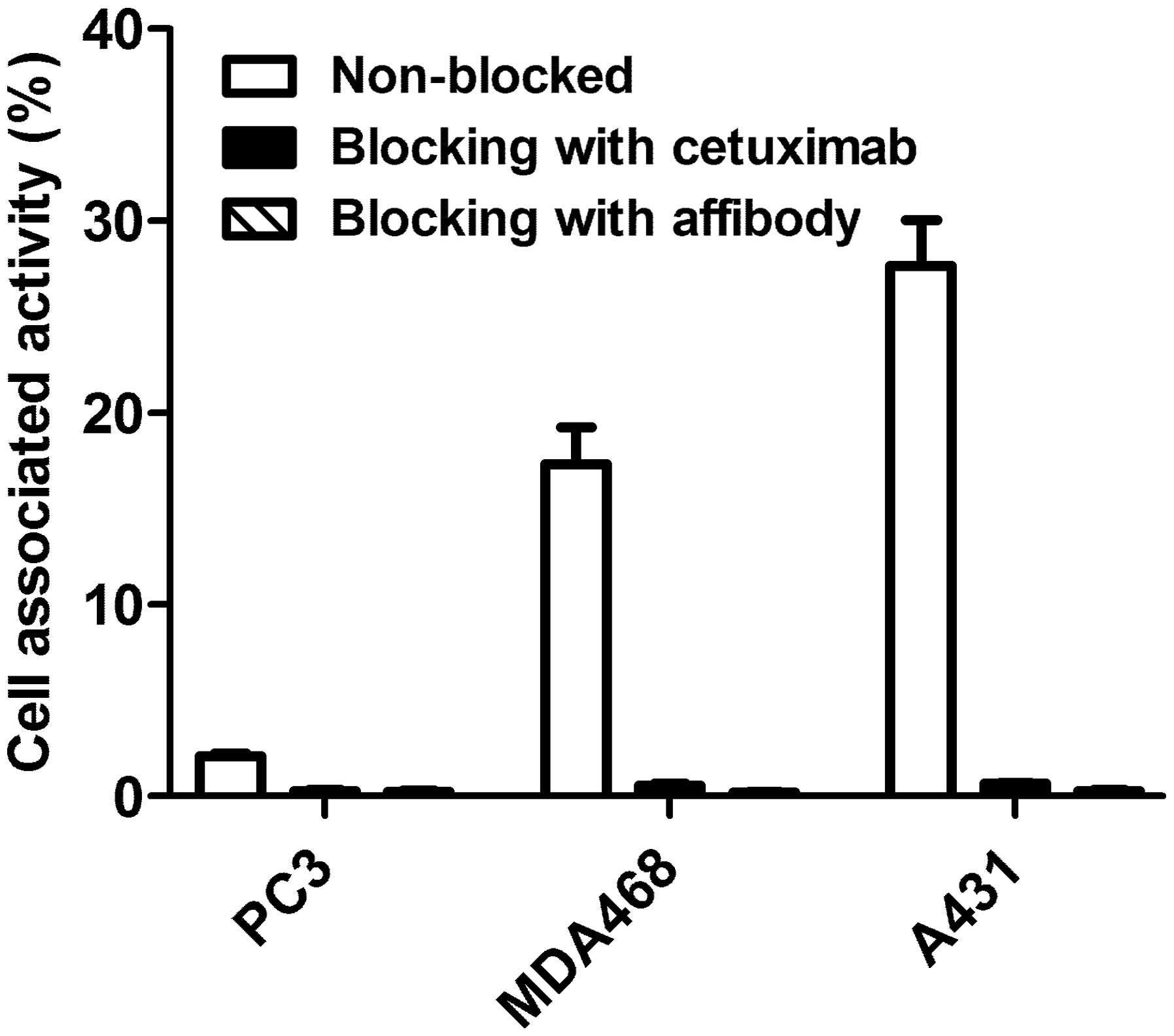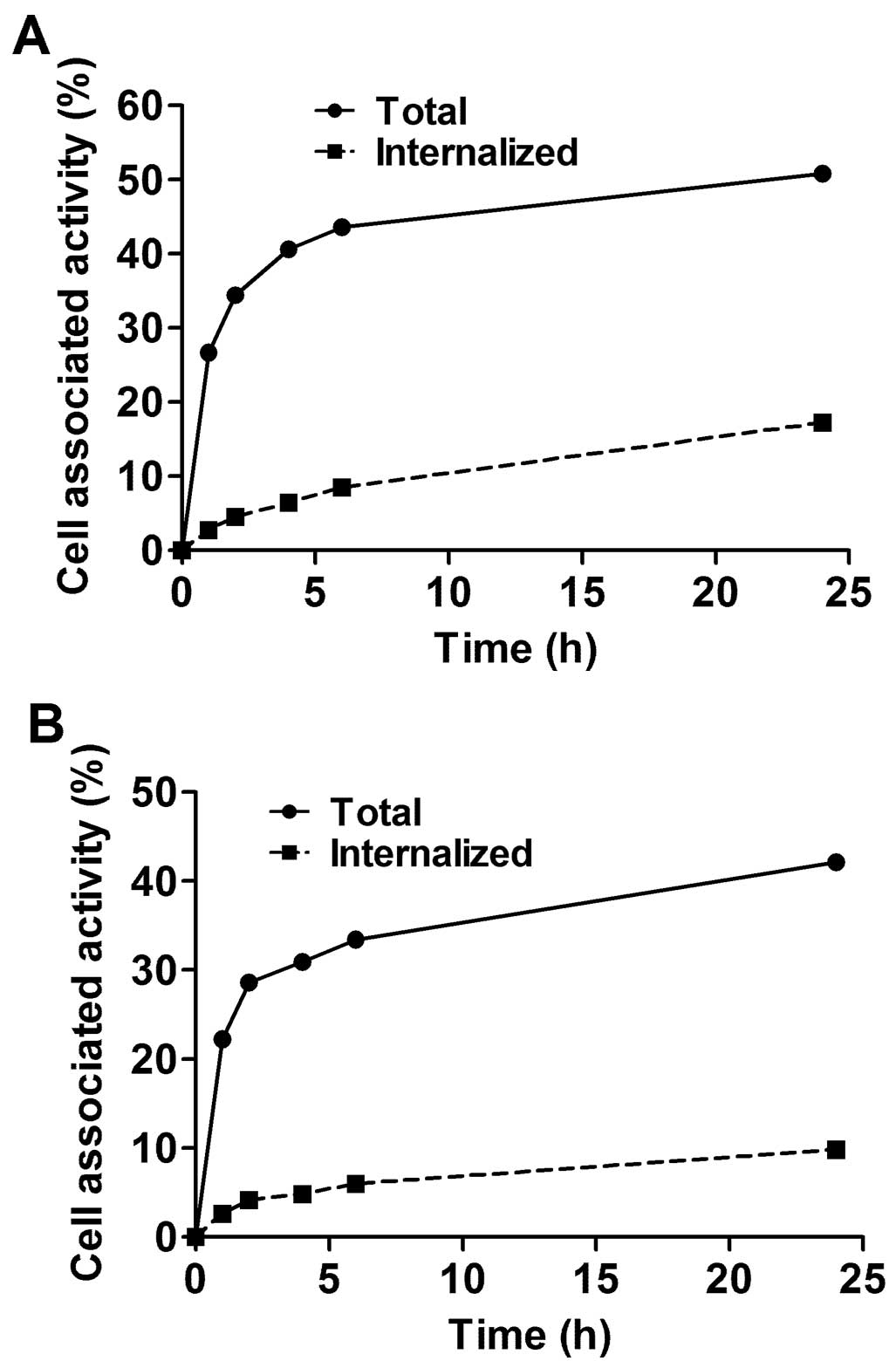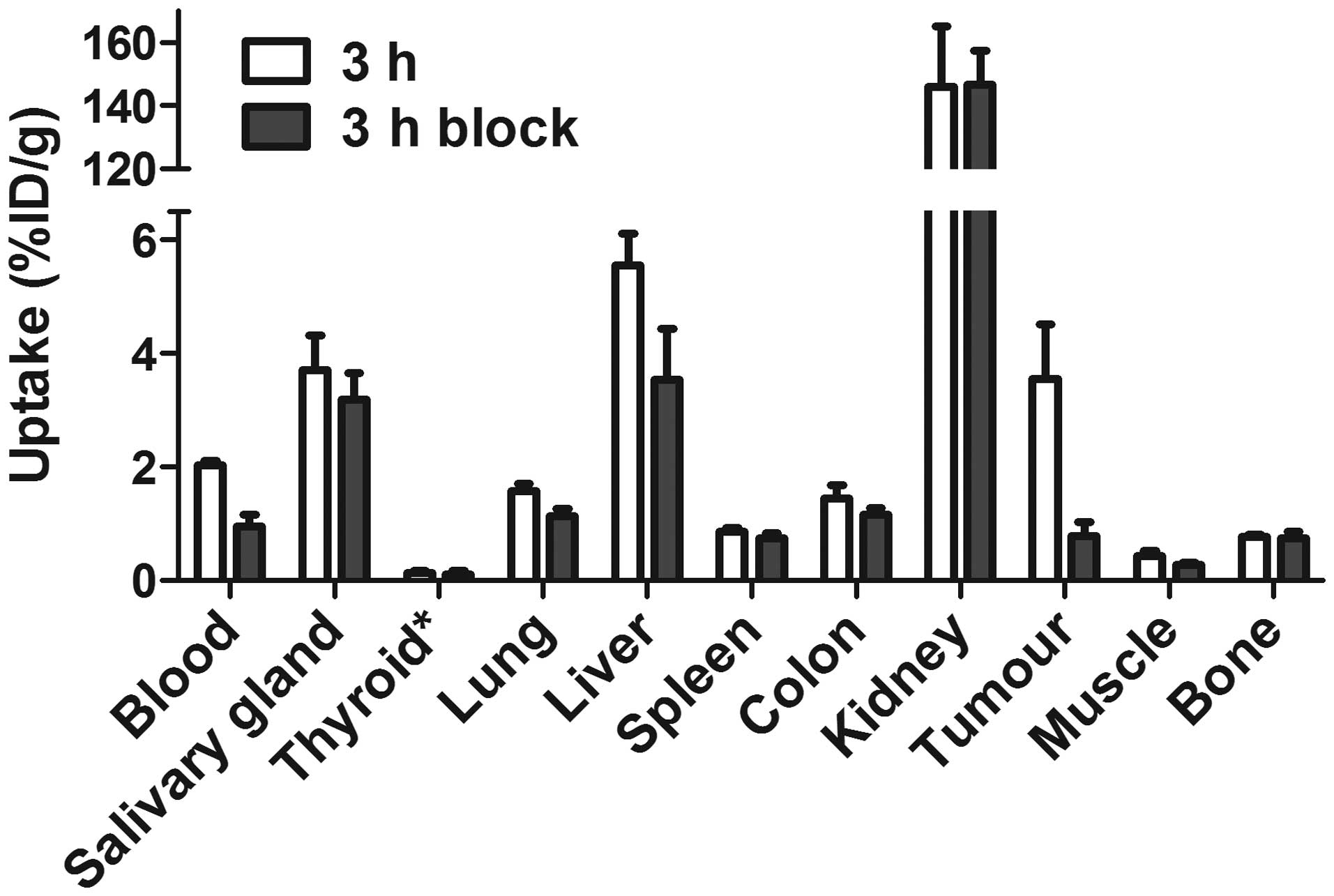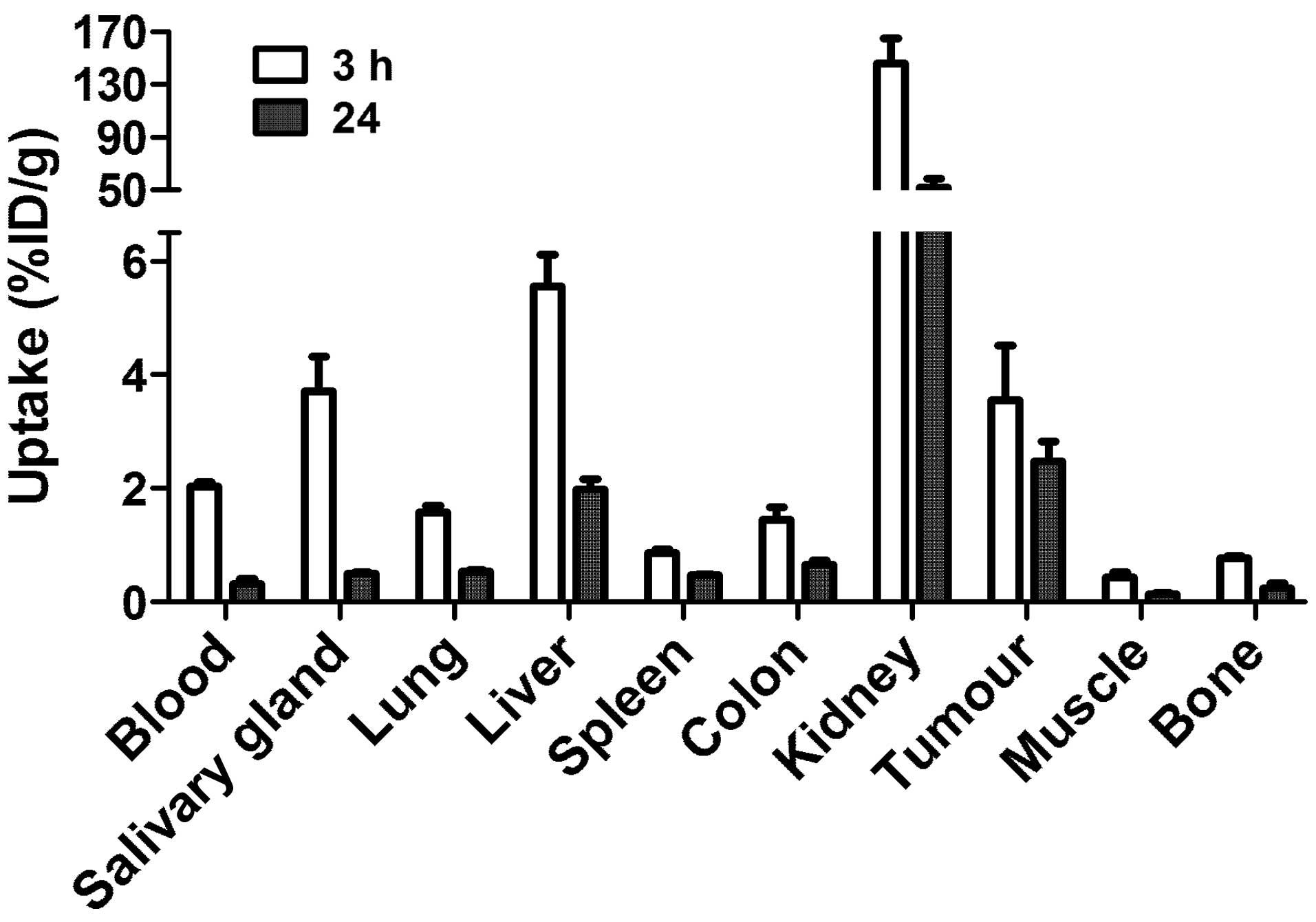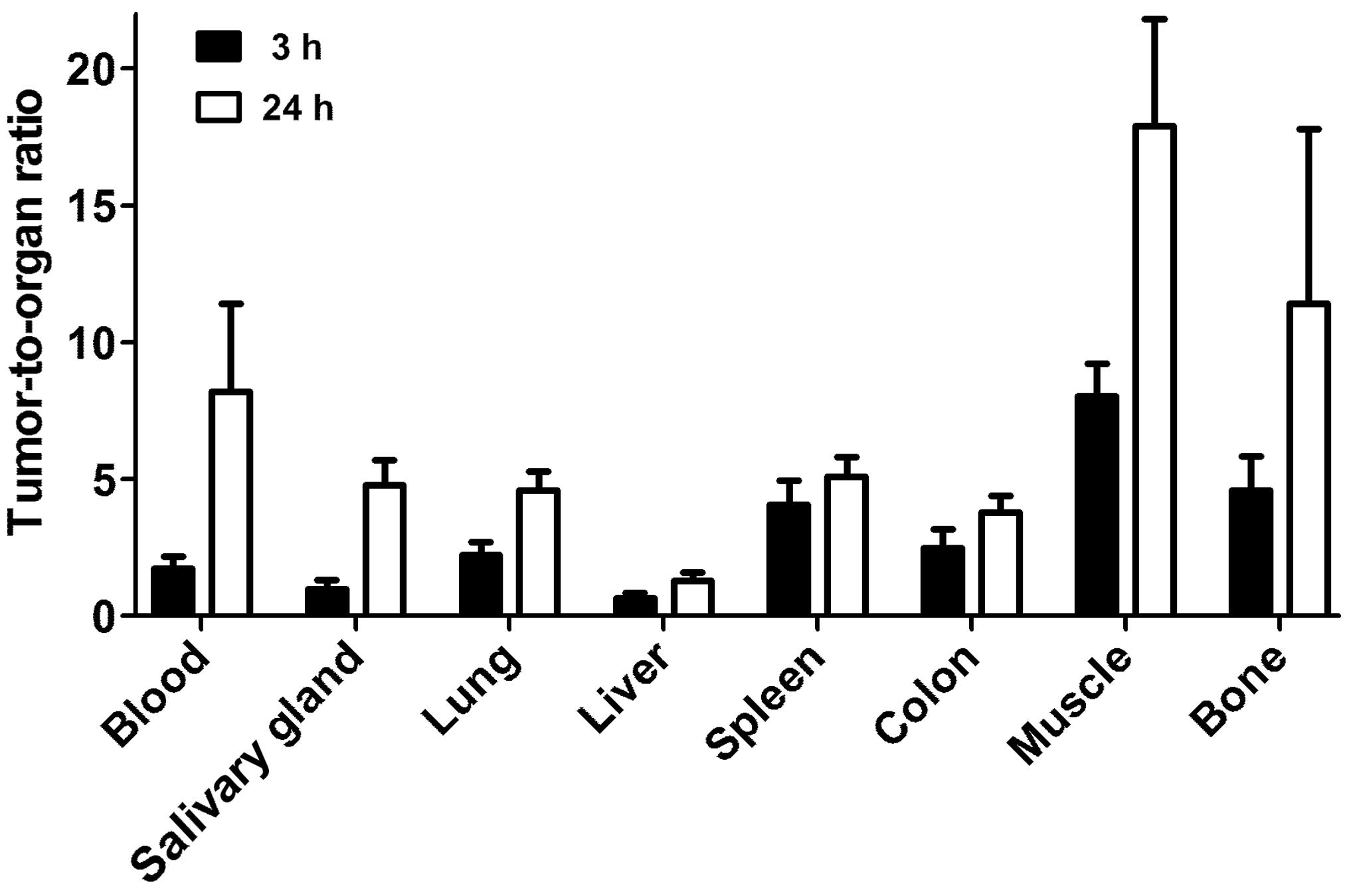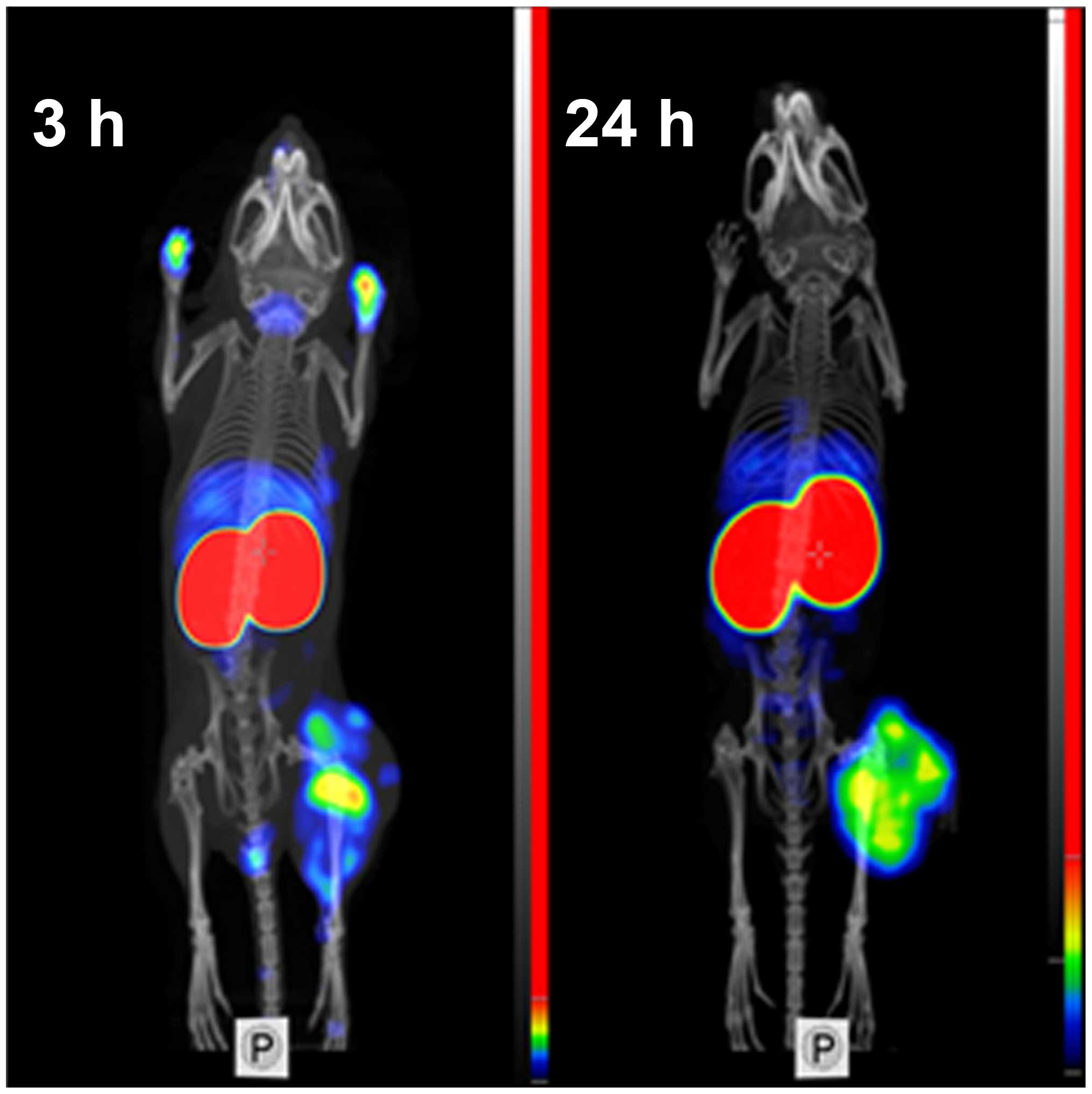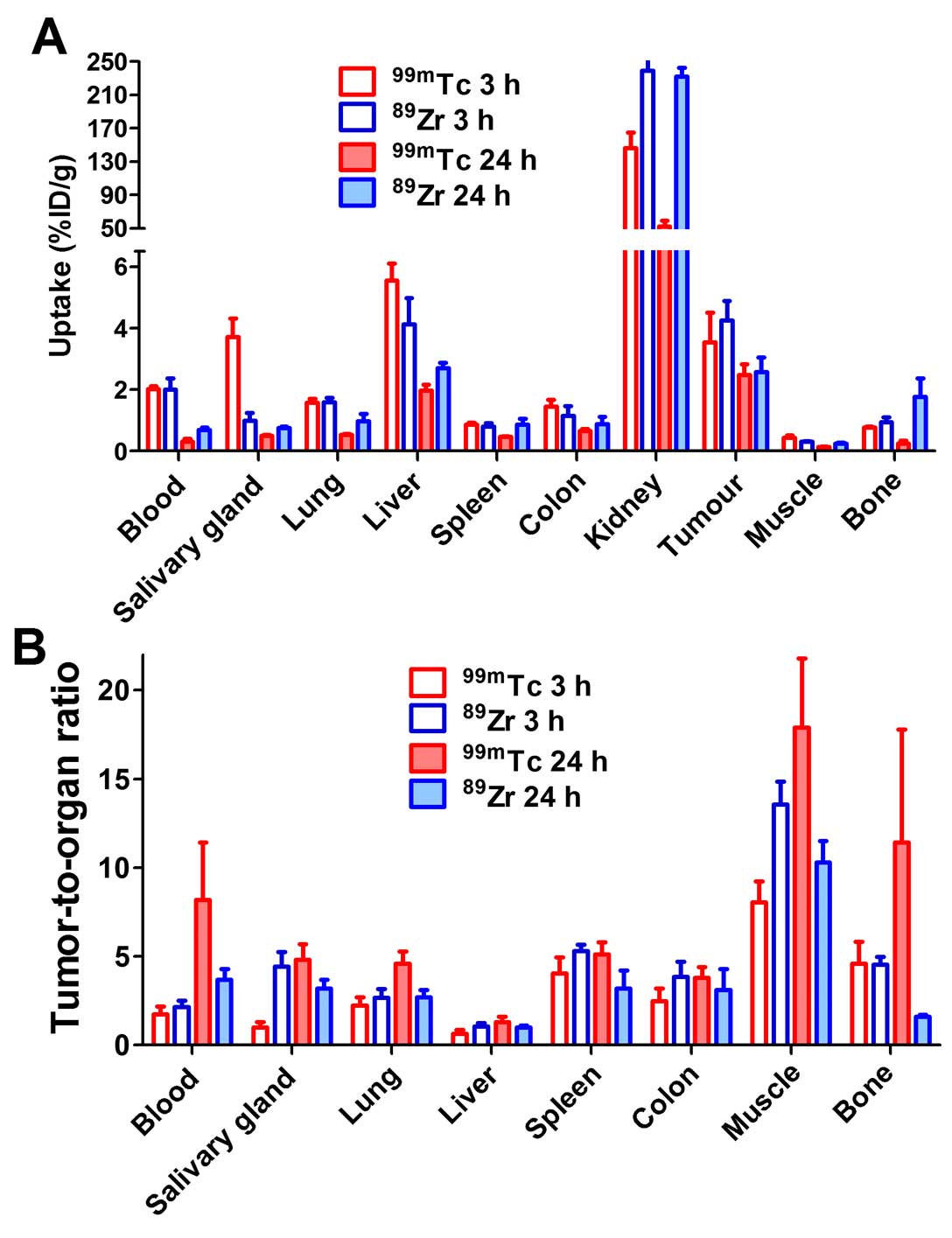|
1
|
Kulkarni HR and Baum RP: Patient selection
for personalized peptide receptor radionuclide therapy using Ga-68
somatostatin receptor PET/CT. PET Clin. 9:83–90. 2014. View Article : Google Scholar : PubMed/NCBI
|
|
2
|
Slobbe P, Poot AJ, Windhorst AD and van
Dongen GA: PET imaging with small-molecule tyrosine kinase
inhibitors: TKI-PET. Drug Discov Today. 17:1175–1187. 2012.
View Article : Google Scholar : PubMed/NCBI
|
|
3
|
Altai M, Orlova A and Tolmachev V:
Radiolabeled probes targeting tyrosine-kinase receptors for
personalized medicine. Curr Pharm Des. 20:2275–2292. 2014.
View Article : Google Scholar
|
|
4
|
Krause DS and Van Etten RA: Tyrosine
kinases as targets for cancer therapy. N Engl J Med. 353:172–187.
2005. View Article : Google Scholar : PubMed/NCBI
|
|
5
|
Salomon DS, Brandt R, Ciardiello F and
Normanno N: Epidermal growth factor-related peptides and their
receptors in human malignancies. Crit Rev Oncol Hematol.
19:183–232. 1995. View Article : Google Scholar : PubMed/NCBI
|
|
6
|
Hedner C, Borg D, Nodin B, Karnevi E,
Jirström K and Eberhard J: Expression and prognostic significance
of human epidermal growth factor receptors 1 and 3 in gastric and
esophageal adenocarcinoma. PLoS One. 11:e01481012016. View Article : Google Scholar : PubMed/NCBI
|
|
7
|
Ueda S, Ogata S, Tsuda H, Kawarabayashi N,
Kimura M, Sugiura Y, Tamai S, Matsubara O, Hatsuse K and Mochizuki
H: The correlation between cytoplasmic overexpression of epidermal
growth factor receptor and tumor aggressiveness: Poor prognosis in
patients with pancreatic ductal adenocarcinoma. Pancreas. 29:e1–e8.
2004. View Article : Google Scholar : PubMed/NCBI
|
|
8
|
Growdon WB, Boisvert SL, Akhavanfard S,
Oliva E, Dias-Santagata DC, Kojiro S, Horowitz NS, Iafrate AJ,
Borger DR and Rueda BR: Decreased survival in EGFR gene amplified
vulvar carcinoma. Gynecol Oncol. 111:289–297. 2008. View Article : Google Scholar : PubMed/NCBI
|
|
9
|
Young RJ, Rischin D, Fisher R, McArthur
GA, Fox SB, Peters LJ, Corry J, Lim A, Waldeck K and Solomon B:
Relationship between epidermal growth factor receptor status,
p16INK4A, and outcome in head and neck squamous cell
carcinoma. Cancer Epidemiol Biomarkers Prev. 20:1230–1237. 2011.
View Article : Google Scholar : PubMed/NCBI
|
|
10
|
Kros JM, Huizer K, Hernández-Laín A,
Marucci G, Michotte A, Pollo B, Rushing EJ, Ribalta T, French P,
Jaminé D, et al: Evidence-based diagnostic algorithm for glioma:
Analysis of the results of Pathology Panel Review and Molecular
Parameters of EORTC 26951 and 26882 Trials. J Clin Oncol.
33:1943–1950. 2015. View Article : Google Scholar : PubMed/NCBI
|
|
11
|
Roskoski R Jr: The ErbB/HER family of
protein-tyrosine kinases and cancer. Pharmacol Res. 79:34–74. 2014.
View Article : Google Scholar
|
|
12
|
Lynch TJ, Bell DW, Sordella R,
Gurubhagavatula S, Okimoto RA, Brannigan BW, Harris PL, Haserlat
SM, Supko JG, Haluska FG, et al: Activating mutations in the
epidermal growth factor receptor underlying responsiveness of
non-small-cell lung cancer to gefitinib. N Engl J Med.
350:2129–2139. 2004. View Article : Google Scholar : PubMed/NCBI
|
|
13
|
Paez JG, Jänne PA, Lee JC, Tracy S,
Greulich H, Gabriel S, Herman P, Kaye FJ, Lindeman N, Boggon TJ, et
al: EGFR mutations in lung cancer: Correlation with clinical
response to gefitinib therapy. Science. 304:1497–1500. 2004.
View Article : Google Scholar : PubMed/NCBI
|
|
14
|
Therkildsen C, Bergmann TK,
Henrichsen-Schnack T, Ladelund S and Nilbert M: The predictive
value of KRAS, NRAS, BRAF, PIK3CA and PTEN for anti-EGFR treatment
in metastatic colorectal cancer: A systematic review and
meta-analysis. Acta Oncol. 53:852–864. 2014. View Article : Google Scholar : PubMed/NCBI
|
|
15
|
Pirker R, Pereira JR, von Pawel J,
Krzakowski M, Ramlau R, Park K, de Marinis F, Eberhardt WE,
Paz-Ares L, Störkel S, et al: EGFR expression as a predictor of
survival for first-line chemotherapy plus cetuximab in patients
with advanced non-small-cell lung cancer: Analysis of data from the
phase 3 FLEX study. Lancet Oncol. 13:33–42. 2012. View Article : Google Scholar
|
|
16
|
Cappuzzo F, Hirsch FR, Rossi E, Bartolini
S, Ceresoli GL, Bemis L, Haney J, Witta S, Danenberg K, Domenichini
I, et al: Epidermal growth factor receptor gene and protein and
gefitinib sensitivity in non-small-cell lung cancer. J Natl Cancer
Inst. 97:643–655. 2005. View Article : Google Scholar : PubMed/NCBI
|
|
17
|
Hirsch FR, Varella-Garcia M, Bunn PA Jr,
Franklin WA, Dziadziuszko R, Thatcher N, Chang A, Parikh P, Pereira
JR, Ciuleanu T, et al: Molecular predictors of outcome with
gefitinib in a phase III placebo-controlled study in advanced
non-small-cell lung cancer. J Clin Oncol. 24:5034–5042. 2006.
View Article : Google Scholar : PubMed/NCBI
|
|
18
|
Bradley JD, Paulus R, Komaki R, Masters G,
Blumenschein G, Schild S, Bogart J, Hu C, Forster K, Magliocco A,
et al: Standard-dose versus high-dose conformal radiotherapy with
concurrent and consolidation carboplatin plus paclitaxel with or
without cetuximab for patients with stage IIIA or IIIB
non-small-cell lung cancer (RTOG 0617): A randomised, two-by-two
factorial phase 3 study. Lancet Oncol. 16:187–199. 2015. View Article : Google Scholar : PubMed/NCBI
|
|
19
|
Ang KK, Berkey BA, Tu X, Zhang HZ, Katz R,
Hammond EH, Fu KK and Milas L: Impact of epidermal growth factor
receptor expression on survival and pattern of relapse in patients
with advanced head and neck carcinoma. Cancer Res. 62:7350–7356.
2002.PubMed/NCBI
|
|
20
|
Bentzen SM, Atasoy BM, Daley FM, Dische S,
Richman PI, Saunders MI, Trott KR and Wilson GD: Epidermal growth
factor receptor expression in pretreatment biopsies from head and
neck squamous cell carcinoma as a predictive factor for a benefit
from accelerated radiation therapy in a randomized controlled
trial. J Clin Oncol. 23:5560–5567. 2005. View Article : Google Scholar : PubMed/NCBI
|
|
21
|
Eriksen JG, Steiniche T and Overgaard J;
Danish Head and Neck Cancer study group (DAHANCA). The influence of
epidermal growth factor receptor and tumor differentiation on the
response to accelerated radiotherapy of squamous cell carcinomas of
the head and neck in the randomized DAHANCA 6 and 7 study.
Radiother Oncol. 74:93–100. 2005. View Article : Google Scholar : PubMed/NCBI
|
|
22
|
Wang X, Niu H, Fan Q, Lu P, Ma C, Liu W,
Liu Y, Li W, Hu S, Ling Y, et al: Predictive value of EGFR
overexpression and gene amplification on icotinib efficacy in
patients with advanced esophageal squamous cell carcinoma.
Oncotarget. 7:24744–24751. 2016.PubMed/NCBI
|
|
23
|
Humbert O, Riedinger JM, Charon-Barra C,
Berriolo-Riedinger A, Desmoulins I, Lorgis V, Kanoun S, Coutant C,
Fumoleau P, Cochet A, et al: Identification of biomarkers including
18FDG-PET/CT for early prediction of response to
neoadjuvant chemotherapy in triple negative breast cancer. Clin
Cancer Res. 21:5460–5468. 2015. View Article : Google Scholar : PubMed/NCBI
|
|
24
|
Vignot S, Besse B, André F, Spano JP and
Soria JC: Discrepancies between primary tumor and metastasis: A
literature review on clinically established biomarkers. Crit Rev
Oncol Hematol. 84:301–313. 2012. View Article : Google Scholar : PubMed/NCBI
|
|
25
|
Divgi CR, Welt S, Kris M, Real FX, Yeh SD,
Gralla R, Merchant B, Schweighart S, Unger M, Larson SM, et al:
Phase I and imaging trial of indium 111-labeled anti-epidermal
growth factor receptor monoclonal antibody 225 in patients with
squamous cell lung carcinoma. J Natl Cancer Inst. 83:97–104. 1991.
View Article : Google Scholar : PubMed/NCBI
|
|
26
|
Cai W, Chen K, He L, Cao Q, Koong A and
Chen X: Quantitative PET of EGFR expression in xenograft-bearing
mice using 64Cu-labeled cetuximab, a chimeric anti-EGFR
monoclonal antibody. Eur J Nucl Med Mol Imaging. 34:850–858. 2007.
View Article : Google Scholar : PubMed/NCBI
|
|
27
|
Nayak TK, Garmestani K, Milenic DE and
Brechbiel MW: PET and MRI of metastatic peritoneal and pulmonary
colorectal cancer in mice with human epidermal growth factor
receptor 1-targeted 89Zr-labeled panitumumab. J Nucl
Med. 53:113–120. 2012. View Article : Google Scholar : PubMed/NCBI
|
|
28
|
Chang AJ, De Silva RA and Lapi SE:
Development and characterization of 89Zr-labeled
panitumumab for immuno-positron emission tomographic imaging of the
epidermal growth factor receptor. Mol Imaging. 12:17–27.
2013.PubMed/NCBI
|
|
29
|
van Dijk LK, Hoeben BA, Kaanders JH,
Franssen GM, Boerman OC and Bussink J: Imaging of epidermal growth
factor receptor expression in head and neck cancer with SPECT/CT
and 111In-labeled cetuximab-F(ab′)2. J Nucl
Med. 54:2118–2124. 2013. View Article : Google Scholar : PubMed/NCBI
|
|
30
|
van Dijk LK, Yim CB, Franssen GM, Kaanders
JH, Rajander J, Solin O, Grönroos TJ, Boerman OC and Bussink J: PET
of EGFR with 64Cu-cetuximab-F(ab′)2 in mice
with head and neck squamous cell carcinoma xenografts. Contrast
Media Mol Imaging. 11:65–70. 2016. View Article : Google Scholar
|
|
31
|
Nygren PA and Skerra A: Binding proteins
from alternative scaffolds. J Immunol Methods. 290:3–28. 2004.
View Article : Google Scholar : PubMed/NCBI
|
|
32
|
Ahlgren S and Tolmachev V: Radionuclide
molecular imaging using Affibody molecules. Curr Pharm Biotechnol.
11:581–589. 2010. View Article : Google Scholar : PubMed/NCBI
|
|
33
|
Sörensen J, Velikyan I, Sandberg D,
Wennborg A, Feldwisch J, Tolmachev V, Orlova A, Sandström M,
Lubberink M, Olofsson H, et al: Measuring HER2-receptor expression
in metastatic breast cancer using [68Ga]ABY-025 affibody
PET/CT. Theranostics. 6:262–271. 2016. View Article : Google Scholar
|
|
34
|
Tolmachev V, Friedman M, Sandström M,
Eriksson TL, Rosik D, Hodik M, Ståhl S, Frejd FY and Orlova A:
Affibody molecules for epidermal growth factor receptor targeting
in vivo: Aspects of dimerization and labeling chemistry. J Nucl
Med. 50:274–283. 2009. View Article : Google Scholar : PubMed/NCBI
|
|
35
|
Tolmachev V, Rosik D, Wållberg H, Sjöberg
A, Sandström M, Hansson M, Wennborg A and Orlova A: Imaging of EGFR
expression in murine xenografts using site-specifically labelled
anti-EGFR 111In-DOTA-ZEGFR:2377 affibody
molecule: aspect of the injected tracer amount. Eur J Nucl Med Mol
Imaging. 37:613–622. 2010. View Article : Google Scholar
|
|
36
|
Miao Z, Ren G, Liu H, Qi S, Wu S and Cheng
Z: PET of EGFR expression with an 18F-labeled affibody
molecule. J Nucl Med. 53:1110–1118. 2012. View Article : Google Scholar : PubMed/NCBI
|
|
37
|
Su X, Cheng K, Jeon J, Shen B, Venturin
GT, Hu X, Rao J, Chin FT, Wu H and Cheng Z: Comparison of two
site-specifically 18F-labeled affibodies for PET imaging
of EGFR positive tumors. Mol Pharm. 11:3947–3956. 2014. View Article : Google Scholar : PubMed/NCBI
|
|
38
|
Garousi J, Andersson KG, Mitran B, Pichl
ML, Ståhl S, Orlova A, Löfblom J and Tolmachev V: PET imaging of
epidermal growth factor receptor expression in tumours using
89Zr-labelled ZEGFR:2377 affibody molecules. Int J
Oncol. 48:1325–1332. 2016.PubMed/NCBI
|
|
39
|
Tolmachev V and Orlova A: Influence of
labelling methods on biodistribution and imaging properties of
radiolabelled peptides for visualisation of molecular therapeutic
targets. Curr Med Chem. 17:2636–2655. 2010. View Article : Google Scholar : PubMed/NCBI
|
|
40
|
Slomka PJ, Pan T, Berman DS and Germano G:
Advances in SPECT and PET Hardware. Prog Cardiovasc Dis.
57:566–578. 2015. View Article : Google Scholar : PubMed/NCBI
|
|
41
|
Banerjee SR, Maresca KP, Francesconi L,
Valliant J, Babich JW and Zubieta J: New directions in the
coordination chemistry of 99mTc: A reflection on
technetium core structures and a strategy for new chelate design.
Nucl Med Biol. 32:1–20. 2005. View Article : Google Scholar : PubMed/NCBI
|
|
42
|
Ahlgren S, Wållberg H, Tran TA, Widström
C, Hjertman M, Abrahmsén L, Berndorff D, Dinkelborg LM, Cyr JE,
Feldwisch J, et al: Targeting of HER2-expressing tumors with a
site-specifically 99mTc-labeled recombinant affibody
molecule, ZHER2:2395, with C-terminally engineered
cysteine. J Nucl Med. 50:781–789. 2009. View Article : Google Scholar : PubMed/NCBI
|
|
43
|
Lindberg H, Hofström C, Altai M, Honorvar
H, Wållberg H, Orlova A, Ståhl S, Gräslund T and Tolmachev V:
Evaluation of a HER2-targeting affibody molecule combining an
N-terminal HEHEHE-tag with a GGGC chelator for
99mTc-labelling at the C terminus. Tumour Biol.
33:641–651. 2012. View Article : Google Scholar : PubMed/NCBI
|
|
44
|
Ahlgren S, Andersson K and Tolmachev V:
Kit formulation for 99mTc-labeling of recombinant
anti-HER2 affibody molecules with a C-terminally engineered
cysteine. Nucl Med Biol. 37:539–546. 2010. View Article : Google Scholar : PubMed/NCBI
|
|
45
|
Hnatowich DJ, Virzi F, Fogarasi M,
Rusckowski M and Winnard P Jr: Can a cysteine challenge assay
predict the in vivo behavior of 99mTc-labeled
antibodies? Nucl Med Biol. 21:1035–1044. 1994. View Article : Google Scholar : PubMed/NCBI
|
|
46
|
Wållberg H and Orlova A: Slow
internalization of anti-HER2 synthetic affibody monomer
111In-DOTA-ZHER2:342-pep2: implications for
development of labeled tracers. Cancer Biother Radiopharm.
23:435–442. 2008. View Article : Google Scholar
|
|
47
|
Sörensen J, Sandberg D, Sandström M,
Wennborg A, Feldwisch J, Tolmachev V, Åström G, Lubberink M,
Garske-Román U, Carlsson J, et al: First-in-human molecular imaging
of HER2 expression in breast cancer metastases using the
111In-ABY-025 affibody molecule. J Nucl Med. 55:730–735.
2014. View Article : Google Scholar
|
|
48
|
Andersson KG, Rosestedt M, Varasteh Z,
Malm M, Sandström M, Tolmachev V, Löfblom J, Ståhl S and Orlova A:
Comparative evaluation of 111In-labeled NOTA-conjugated
affibody molecules for visualization of HER3 expression in
malignant tumors. Oncol Rep. 34:1042–1048. 2015.PubMed/NCBI
|
|
49
|
Mitran B, Altai M, Hofström C, Honarvar H,
Sandström M, Orlova A, Tolmachev V and Gräslund T: Evaluation of
99mTc-Z IGF1R:4551-GGGC affibody molecule, a
new probe for imaging of insulin-like growth factor type 1 receptor
expression. Amino Acids. 47:303–315. 2015. View Article : Google Scholar
|
|
50
|
Tolmachev V, Varasteh Z, Honarvar H,
Hosseinimehr SJ, Eriksson O, Jonasson P, Frejd FY, Abrahmsen L and
Orlova A: Imaging of platelet-derived growth factor receptor β
expression in glioblastoma xenografts using affibody molecule
111In-DOTA-Z09591. J Nucl Med. 55:294–300. 2014.
View Article : Google Scholar : PubMed/NCBI
|
|
51
|
Honarvar H, Garousi J, Gunneriusson E,
Höidén-Guthenberg I, Altai M, Widström C, Tolmachev V and Frejd FY:
Imaging of CAIX-expressing xenografts in vivo using
99mTc-HEHEHE-ZCAIX:1 affibody molecule. Int J Oncol.
46:513–520. 2015.
|
|
52
|
Altai M, Honarvar H, Wållberg H, Strand J,
Varasteh Z, Rosestedt M, Orlova A, Dunås F, Sandström M, Löfblom J,
et al: Selection of an optimal cysteine-containing peptide-based
chelator for labeling of affibody molecules with 188Re.
Eur J Med Chem. 87:519–528. 2014. View Article : Google Scholar : PubMed/NCBI
|
|
53
|
Wållberg H, Orlova A, Altai M,
Hosseinimehr SJ, Widström C, Malmberg J, Ståhl S and Tolmachev V:
Molecular design and optimization of 99mTc-labeled
recombinant affibody molecules improves their biodistribution and
imaging properties. J Nucl Med. 52:461–469. 2011. View Article : Google Scholar
|
|
54
|
Altai M, Wållberg H, Orlova A, Rosestedt
M, Hosseinimehr SJ, Tolmachev V and Ståhl S: Order of amino acids
in C-terminal cysteine-containing peptide-based chelators
influences cellular processing and biodistribution of
99mTc-labeled recombinant Affibody molecules. Amino
Acid. 42:1975–1985. 2012. View Article : Google Scholar
|
|
55
|
Moffat FL Jr, Pinsky CM, Hammershaimb L,
Petrelli NJ, Patt YZ, Whaley FS and Goldenberg DM; The Immunomedics
Study Group. Clinical utility of external immunoscintigraphy with
the IMMU-4 technetium-99m Fab′ antibody fragment in patients
undergoing surgery for carcinoma of the colon and rectum: Results
of a pivotal, phase III trial. J Clin Oncol. 14:2295–2305.
1996.PubMed/NCBI
|
|
56
|
Serafini AN, Klein JL, Wolff BG, Baum R,
Chetanneau A, Pecking A, Fischman AJ, Hoover HC Jr, Wynant GE,
Subramanian R, et al: Radioimmunoscintigraphy of recurrent,
metastatic, or occult colorectal cancer with technetium 99m-labeled
totally human monoclonal antibody 88BV59: Results of pivotal, phase
III multicenter studies. J Clin Oncol. 16:1777–1787.
1998.PubMed/NCBI
|
|
57
|
Schwochau K: Technetium
radiopharmaceuticals: Fundamentals, synthesis, structure and
development. Angew Chem Int Ed Engl. 33:2258–2267. 1994. View Article : Google Scholar
|



